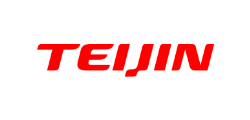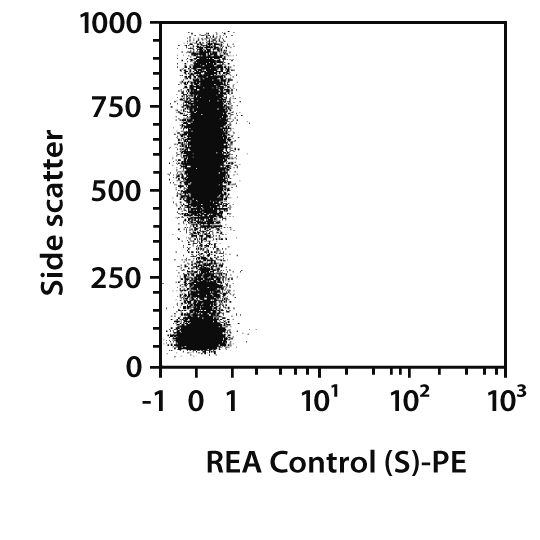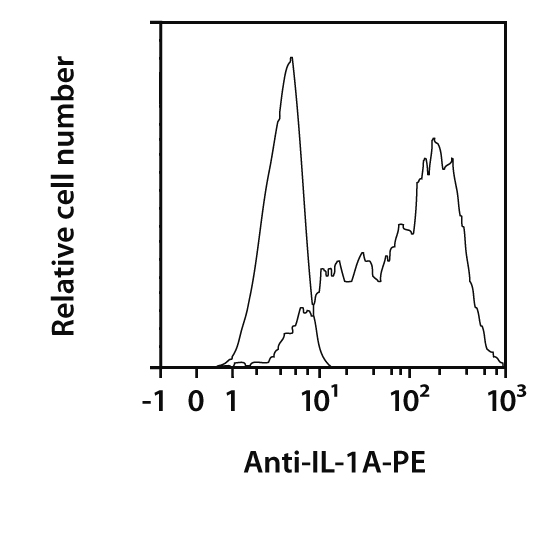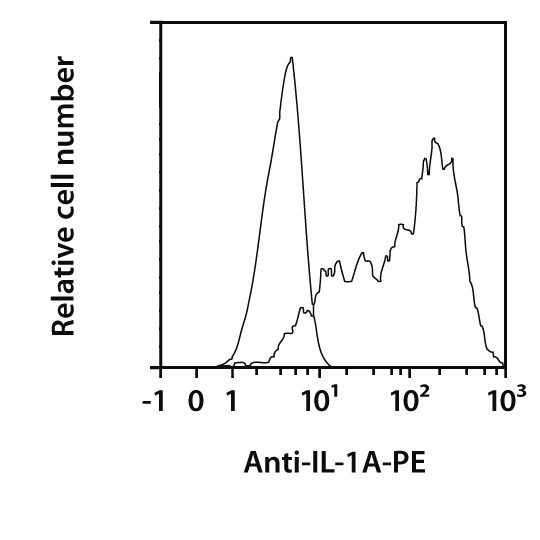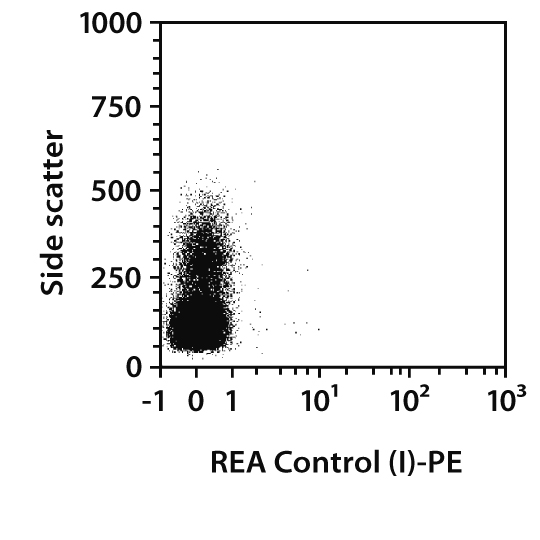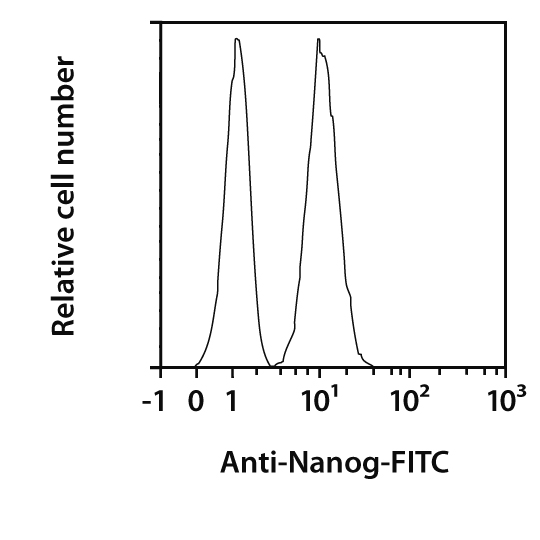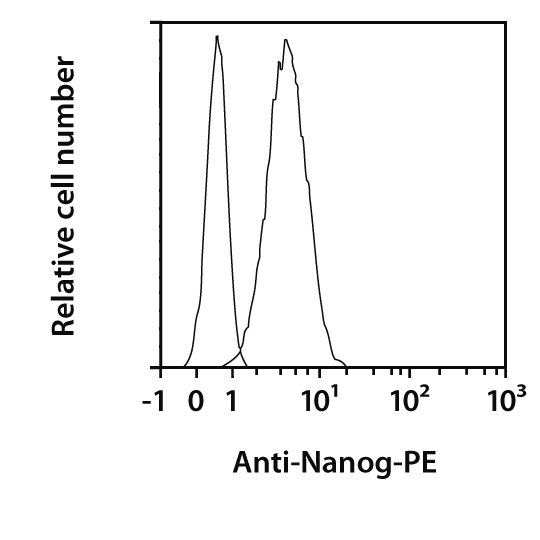Recombinant antibody
Code: 130-104-545
Overview
Clone REA303 recognizes HLA-DQ, an αβ heterodimer of the MHC class II type. Expressed on the surface of most nucleated cells, MHC class II molecules play an important role in the immune system. They are essential in the defense against infection and are a main consideration in transplantation medicine. In addition to presenting antigenic peptides from predominantly extracellular sources to CD4
+
T cells, MHC class II molecules also mediate the thymic selection of T helper cells. MHC class II molecules consist of an α and β chain and are transported to endosomal-lysosomal compartments by the invariant chain. In humans, MHC class II molecules are encoded by three different loci, HLA-DR, -DQ, and -DP, which display 70% similarity to each other. Both chains of HLA-DQ are polymorphic. Despite the essential function of MHC class II molecules in immune defense against pathogens, some alleles are frequently linked to immune diseases. Two autoimmune diseases in which HLA-DQ is involved are coeliac disease and diabetes mellitus type 1.
Additional information: Clone REA303 displays negligible binding to Fc receptor
Alternative names
HLA-DQA1, HLA-DQA2, HLA-DQB1, HLA-DQB2Specifications
- Human : 0
- PE : 0
- 30 tests : 0
- 0.3 ml : 0
- Recombinant Human IgG1 : 0
Code: 130-104-481
Overview
Clone REA288 recognizes the precursor, secreted and membrane-associated forms of the mouse interleukin-1α (IL-1α) protein. IL-1α is a unique member in the cytokine family in the sense that the structure of its initially synthesized precursor does not contain a signal peptide fragment. After processing by the removal of N-terminal amino acids by specific proteases, the resulting peptide is called "mature" form. Both the 31kDa precursor form of IL-1α and its 18kDa mature form are biologically active. IL-1α is produced mainly by activated macrophages, as well as neutrophils, epithelial cells, and endothelial cells. It possesses metabolic, physiological, haematopoietic activities, and plays one of the central roles in the regulation of the immune responses. It binds to the interleukin-1 receptor type I (IL-1R1).
Additional information: Clone REA288 displays negligible binding to Fc receptors.
Alternative names
Interleukin-1 α (IL-1 α)Specifications
- PE : 0
- Mouse : 0
- 200 tests : 0
- 30 µg in 1 mL : 0
- Recombinant Human IgG1 : 0
Code: 130-104-530
Overview
Clone REA288 recognizes the precursor, secreted and membrane-associated forms of the mouse interleukin-1α (IL-1α) protein. IL-1α is a unique member in the cytokine family in the sense that the structure of its initially synthesized precursor does not contain a signal peptide fragment. After processing by the removal of N-terminal amino acids by specific proteases, the resulting peptide is called "mature" form. Both the 31kDa precursor form of IL-1α and its 18kDa mature form are biologically active. IL-1α is produced mainly by activated macrophages, as well as neutrophils, epithelial cells, and endothelial cells. It possesses metabolic, physiological, haematopoietic activities, and plays one of the central roles in the regulation of the immune responses. It binds to the interleukin-1 receptor type I (IL-1R1).
Additional information: Clone REA288 displays negligible binding to Fc receptors.
Alternative names
Interleukin-1 α (IL-1 α)Specifications
- PE : 0
- Mouse : 0
- 60 tests : 0
- 9 µg in 300 µL : 0
- Recombinant Human IgG1 : 0
Code: 130-104-702
Overview
Clone REA310 recognizes the interferon regulatory factor 7 (IRF-7) phosphorylated at serines 477 and 479 (pS477/pS479). IRF-7 is a member of the IRF family of transcription factors and a key player in the innate immune response against viral infections. Constitutive expression of IRF-7 is limited to peripheral blood lymphocytes and dendritic cells while in most cell types its expression can be induced by type I interferon. IRF-7 is sequestered in the cytoplasm of uninfected cells and following viral infection, double-stranded RNA, or toll-like receptor signaling, it becomes phosphorylated by TBK and IKK-i kinases. Phosphorylated IRF-7 migrates in the nucleus where it can activate interferon type I genes and other interferon-stimulated genes.
Additional information: Clone REA310 displays negligible binding to Fc receptors.
Alternative names
IRF7, IMD39, IRF-7H, IRF7A, IRF7B, IRF7CSpecifications
- Human : 0
- PE : 0
- 100 tests : 0
- 1 mL : 0
- Recombinant Human IgG1 : 0
Code: 130-104-478
Overview
Clone REA297 recognizes the murine Nanog antigen, a homeobox transcription factor also known as ES cell-associated protein 4. Nanog is thought to be a key factor in maintaining pluripotency. It is expressed in the central portion of the morula, the inner cell mass of the blastocyst, in embryonic stem cells (ESC) and embryonic germ cells (EGC). The expression decreases with ESC differentiation. Nanog is thought to function in concert with other factors such as Oct-4 and SOX2 to establish ESC identity. Overexpression of Nanog in mouse ESC causes them to self-renew in the absence of Leukemia inhibitory factor. Loss of Nanog function causes differentiation of mouse ESC into other cell types.
Additional information: Clone REA297 displays negligible binding to Fc receptors.
Alternative names
ENK, ecat4, Early embryo specific expression NK-type homeobox proteinSpecifications
- FITC : 0
- Mouse : 0
- 200 tests : 0
- 30 µg in 1 mL : 0
- Recombinant Human IgG1 : 0
Code: 130-104-527
Overview
Clone REA297 recognizes the murine Nanog antigen, a homeobox transcription factor also known as ES cell-associated protein 4. Nanog is thought to be a key factor in maintaining pluripotency. It is expressed in the central portion of the morula, the inner cell mass of the blastocyst, in embryonic stem cells (ESC) and embryonic germ cells (EGC). The expression decreases with ESC differentiation. Nanog is thought to function in concert with other factors such as Oct-4 and SOX2 to establish ESC identity. Overexpression of Nanog in mouse ESC causes them to self-renew in the absence of Leukemia inhibitory factor. Loss of Nanog function causes differentiation of mouse ESC into other cell types.
Additional information: Clone REA297 displays negligible binding to Fc receptors.
Alternative names
ENK, ecat4, Early embryo specific expression NK-type homeobox proteinSpecifications
- FITC : 0
- Mouse : 0
- 60 tests : 0
- 9 µg in 300 µL : 0
- Recombinant Human IgG1 : 0
Code: 130-104-479
Overview
Clone REA297 recognizes the murine Nanog antigen, a homeobox transcription factor also known as ES cell-associated protein 4. Nanog is thought to be a key factor in maintaining pluripotency. It is expressed in the central portion of the morula, the inner cell mass of the blastocyst, in embryonic stem cells (ESC) and embryonic germ cells (EGC). The expression decreases with ESC differentiation. Nanog is thought to function in concert with other factors such as Oct-4 and SOX2 to establish ESC identity. Overexpression of Nanog in mouse ESC causes them to self-renew in the absence of Leukemia inhibitory factor. Loss of Nanog function causes differentiation of mouse ESC into other cell types.
Additional information: Clone REA297 displays negligible binding to Fc receptors.
Alternative names
ENK, ecat4, Early embryo specific expression NK-type homeobox proteinSpecifications
- PE : 0
- Mouse : 0
- 200 tests : 0
- 30 µg in 1 mL : 0
- Recombinant Human IgG1 : 0
Code: 130-104-528
Overview
Clone REA297 recognizes the murine Nanog antigen, a homeobox transcription factor also known as ES cell-associated protein 4. Nanog is thought to be a key factor in maintaining pluripotency. It is expressed in the central portion of the morula, the inner cell mass of the blastocyst, in embryonic stem cells (ESC) and embryonic germ cells (EGC). The expression decreases with ESC differentiation. Nanog is thought to function in concert with other factors such as Oct-4 and SOX2 to establish ESC identity. Overexpression of Nanog in mouse ESC causes them to self-renew in the absence of Leukemia inhibitory factor. Loss of Nanog function causes differentiation of mouse ESC into other cell types.
Additional information: Clone REA297 displays negligible binding to Fc receptors.
Alternative names
ENK, ecat4, Early embryo specific expression NK-type homeobox proteinSpecifications
- PE : 0
- Mouse : 0
- 60 tests : 0
- 9 µg in 300 µL : 0
- Recombinant Human IgG1 : 0



